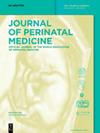Left atrial strain in fetal echocardiography – could it be introduced to everyday clinical practice?
IF 1.7
4区 医学
Q3 OBSTETRICS & GYNECOLOGY
引用次数: 0
Abstract
Objectives Prenatal cardiology is a part of preventive cardiology based on fetal echocardiography and fetal interventional cardiology, which facilitates treatment of congenital heart defects (CHD) in pediatric patients and consequently in adults. Timely prenatal detection of CHD plays a pivotal role in facilitating the appropriate referral of pregnant women to facilities equipped to provide thorough perinatal care within the framework of a well-structured healthcare system. The aim of this paper is to highlight the role of left atrial strain (LAS) in prenatal evaluation of fetal heart and prediction of structural and functional disorders. Methods We conducted a comprehensive literature review searching PubMed for articles published from inception up until August 2023, including the search terms “left atrial strain”, “fetal echocardiography”, and “prenatal cardiology” combined through Boolean operators. In addition, references lists of identified articles were further reviewed for inclusion. Results Our review underscores the significance of LAS parameters in fetal echocardiography as a screening tool during specific gestational windows (starting from 11 to 14 weeks of gestation, followed by better visualization between 18 and 22 weeks of gestation). The left atrial strain technique and its parameters serve as valuable indicators, not only for identifying cardiac complications but also for predicting and guiding therapeutic interventions in cases of both cardiac and noncardiac pregnancy complications in fetuses. Evidence suggests establishment of second-trimester reference strain and strain rate values by speckle-tracking echocardiography in the healthy fetal cohort is essential for the evaluation of myocardial pathologies during pregnancy. Conclusions Finding of LAS of fetal heart is feasible and probably can have potential for clinical and prognostic implications.胎儿超声心动图中的左心房应变--能否应用于日常临床实践?
目的产前心脏病学是预防心脏病学的一部分,以胎儿超声心动图和胎儿介入心脏病学为基础,为儿童和成人先天性心脏缺陷的治疗提供便利。在一个结构良好的医疗系统框架内,及时的产前检测冠心病在促进孕妇适当转诊到有设备的机构提供全面的围产期护理方面起着关键作用。本文的目的是强调左心房应变(LAS)在胎儿心脏的产前评估和预测结构和功能障碍中的作用。方法在PubMed检索自成立以来至2023年8月发表的文献,检索词为“左心房应变”、“胎儿超声心动图”和“产前心脏病学”,通过布尔运算符组合。此外,还进一步审查了已确定文章的参考文献清单,以便纳入。结果:我们的综述强调了LAS参数在胎儿超声心动图中作为特定妊娠窗期(妊娠11 - 14周开始,妊娠18 - 22周期间更好的可视化)筛查工具的重要性。左心房应变技术及其参数不仅是识别心脏并发症的重要指标,而且对胎儿心源性和非心源性妊娠并发症的预测和指导治疗干预具有重要意义。有证据表明,通过斑点跟踪超声心动图在健康胎儿队列中建立妊娠中期参考应变和应变率值对于评估妊娠期间心肌病理至关重要。结论发现胎儿心脏LAS是可行的,可能具有潜在的临床和预后意义。
本文章由计算机程序翻译,如有差异,请以英文原文为准。
求助全文
约1分钟内获得全文
求助全文
来源期刊

Journal of Perinatal Medicine
医学-妇产科学
CiteScore
4.40
自引率
8.30%
发文量
183
审稿时长
4-8 weeks
期刊介绍:
The Journal of Perinatal Medicine (JPM) is a truly international forum covering the entire field of perinatal medicine. It is an essential news source for all those obstetricians, neonatologists, perinatologists and allied health professionals who wish to keep abreast of progress in perinatal and related research. Ahead-of-print publishing ensures fastest possible knowledge transfer. The Journal provides statements on themes of topical interest as well as information and different views on controversial topics. It also informs about the academic, organisational and political aims and objectives of the World Association of Perinatal Medicine.
 求助内容:
求助内容: 应助结果提醒方式:
应助结果提醒方式:


